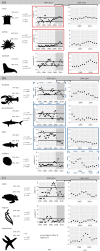Increases and decreases in marine disease reports in an era of global change
- PMID: 31594507
- PMCID: PMC6790777
- DOI: 10.1098/rspb.2019.1718
Increases and decreases in marine disease reports in an era of global change
Abstract
Outbreaks of marine infectious diseases have caused widespread mass mortalities, but the lack of baseline data has precluded evaluating whether disease is increasing or decreasing in the ocean. We use an established literature proxy method from Ward and Lafferty (Ward and Lafferty 2004 PLoS Biology2, e120 (doi:10.1371/journal.pbio.0020120)) to analyse a 44-year global record of normalized disease reports from 1970 to 2013. Major marine hosts are combined into nine taxonomic groups, from seagrasses to marine mammals, to assess disease swings, defined as positive or negative multi-decadal shifts in disease reports across related hosts. Normalized disease reports increased significantly between 1970 and 2013 in corals and urchins, indicating positive disease swings in these environmentally sensitive ectotherms. Coral disease reports in the Caribbean correlated with increasing temperature anomalies, supporting the hypothesis that warming oceans drive infectious coral diseases. Meanwhile, disease risk may also decrease in a changing ocean. Disease reports decreased significantly in fishes and elasmobranchs, which have experienced steep human-induced population declines and diminishing population density that, while concerning, may reduce disease. The increases and decreases in disease reports across the 44-year record transcend short-term fluctuations and regional variation. Our results show that long-term changes in disease reports coincide with recent decades of widespread environmental change in the ocean.
Keywords: infectious disease; literature proxy; marine; temperature anomalies.
Conflict of interest statement
We declare we have no competing interests.
Figures



References
-
- Lavigne D, Schmitz O. 1990. Global warming and increasing population densities: a prescription for seal plagues. Mar. Pollut. Bull. 21, 280–284. (10.1016/0025-326x(90)90590-5) - DOI
Publication types
MeSH terms
Associated data
LinkOut - more resources
Full Text Sources

